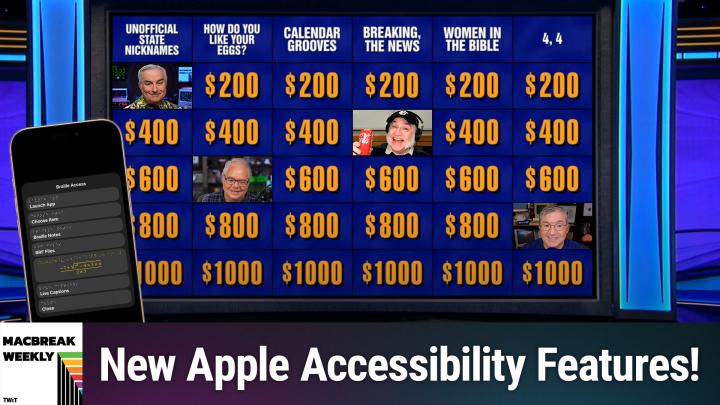Apple Unveils Impressive New Accessibility Features Ahead of WWDC
AI-created, human-reviewed.
In a recent episode of MacBreak Weekly, hosts Leo Laporte, Andy Ihnatko, Alex Lindsay, and Jason Snell discussed Apple's previews of significant accessibility features before WWDC, giving us an early look at innovations coming to iOS 19, macOS 15.5, and other Apple platforms later this year.
"Apple at Its Best"
The MacBreak Weekly team noted that these accessibility announcements represent "Apple at its best." As Jason Snell pointed out, while recent discussions about Apple have often centered around court rulings, App Store policies, and other controversies, these accessibility innovations remind us of Apple's commitment to creating technology that works for everyone.
"This stuff is Apple at its best," Snell emphasized, with Andy Ihnatko adding that accessibility is an area where big tech companies like Apple and Google are "very, very happily competing with each other" to create better solutions.
Key Accessibility Features Coming to Apple Devices
App Store Accessibility Labels
One of the most practical new features will be accessibility "nutrition labels" for apps in the App Store. Similar to the privacy labels introduced previously, these will allow users to see at a glance which accessibility features an app supports before downloading. As discussed on the show, this creates visibility and accountability, potentially encouraging more developers to prioritize accessibility in their apps.
Magnifier App Comes to Mac
The Magnifier app, already available on iOS, will be coming to Mac with Continuity Camera support. This powerful feature allows users with low vision to use their iPhone camera as a remote magnifier while viewing the enhanced image on their Mac. As Jason Snell explained, this could be tremendously helpful for students who have trouble seeing whiteboards or presentations in class.
Text Reading Enhancements
Apple is introducing improved text reading capabilities that will reformat text to make it more readable – with options for high contrast, larger fonts, and simplified layouts. Andy Ihnatko noted this feature's universal appeal, mentioning similar functionality he uses on Android to bypass cluttered web pages with too many ads.
Braille Access
A new feature called Braille Access will turn Apple devices into full-featured Braille note-takers when used with compatible Braille displays. The MacBreak Weekly team was impressed to learn that one of their community members was actively participating in their Discord using such technology.
Live Captions on Apple Watch
In an interesting expansion of accessibility features across the ecosystem, Live Captions will be coming to Apple Watch. This feature allows the iPhone to serve as a remote microphone, streaming audio to connected devices while displaying real-time captions on the wearer's Apple Watch.
Personal Voice Improvements
Personal Voice, which allows users at risk of losing their speech to create a synthesized version of their voice, is getting significant upgrades. According to information shared on the show, the training process will be reduced from 150 phrases to just 10, and voice generation will take minutes instead of overnight processing.
Alex Lindsay noted that while this streamlined approach is valuable, especially for those with limited time to capture their voice, some professional voice preservation services like 11 Labs still offer more detailed voice modeling with additional training data.
Brain-Computer Interface Support
In one of the most forward-looking announcements, Apple revealed they're building support for brain-computer interfaces into their Switch Control accessibility system. As reported in the Wall Street Journal, Apple is working with a company called Synchron to create a standardized way for users to control Apple devices through neural signals – a breakthrough for people with severe mobility restrictions.
Vehicle Motion Cues for Mac
A feature already available on iOS that displays motion cues to reduce motion sickness will be coming to Mac. These visual indicators move in sync with vehicle motion, helping to alleviate the disconnect between what users see and what their inner ear senses when using devices in moving vehicles.
Sound Recognition for Names
Sound Recognition will be enhanced to include name recognition, allowing users who are deaf or hard of hearing to know when someone is calling their name – a thoughtful addition that addresses a specific everyday challenge.
The Competitive Landscape of Accessibility
The hosts noted that while Apple deserves credit for these innovations, companies like Google and Microsoft are also making significant strides in accessibility. This healthy competition benefits users as features pioneered by one company often inspire similar implementations elsewhere.
"This is one area in security in which both Apple and Google are very, very happily competing with each other," noted Andy Ihnatko, explaining that accessibility teams at these companies openly acknowledge when they're inspired by each other's work.
Looking Toward the Future
Some of these features, particularly the brain-computer interface support, hint at Apple's future directions. As Jason Snell observed, Apple often "builds foundational technologies for future products in public" that later become integral to new devices.
This pattern of establishing accessibility frameworks ahead of hardware launches suggests Apple's rumored AR glasses and other future products may incorporate accessibility from the ground up rather than as an afterthought.
In Conclusion
The MacBreak Weekly discussion highlighted how Apple's accessibility innovations demonstrate the company's ability to use its technical prowess to make meaningful improvements in people's lives. As these features roll out with iOS 19 and macOS 15.5 later this year, they'll not only assist users with specific needs but also improve the experience for everyone – a hallmark of thoughtful accessibility design.
